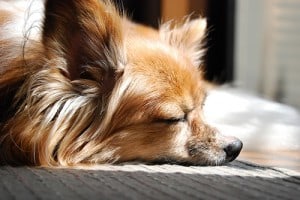Usually very high on the list of training priorities for a Papillon puppy or a dog is the issue of house training.
Teaching your Papillon to avoid eliminating in the house is important for several reasons – the most obvious of which is the odour and mess that a non-house broken dog will make.
In addition, there are health concerns for the humans, dog and other animals if there is fecal material in the same area that food is prepared or consumed.
Often dogs will eat their own waste, so keeping the animal away from this material is also important to prevent bad and unsafe habits from forming.
The concerns with coprophagia (fecal eating) will be discussed in a separate article.
Crate Training
One of the most successful ways to train a puppy is to use the crate training method. The crate is seen by the dog as a safe area or den that he or she can use to sleep in, or just to spend time.
There are several benefits to crate training your puppy that will continue to be useful as your dog matures.
A crate provides an excellent environment for transporting your Papillon, a comfortable yet confined place when you are not at home, a method to control challenging behaviours such as digging and chewing, as well as a tool for scheduling toileting, sleeping and other activities.
Paper training
Paper training is a great option if you are not able to be at home with your puppy to crate train. Start with a small area that you can confine the puppy to. It is important that there be no carpet in the area, and that the floor be easy to clean.
Place a layer of newspaper or other paper over the entire floor area. The puppy will simply go where the urge strikes him, but he will always be eliminating on paper.
Clean the paper every morning and evening, or more often if possible.
You should begin to notice that the puppy only messes in certain areas of the room. Begin taking up the paper that is in areas that the puppy does not mess in.
Gradually decrease the amount of paper in the room until you have a small, manageable area. If the puppy messes outside of this area, simply cover that area with paper and start decreasing the size again.
Once the puppy is only using the paper that you have placed down, you can begin gradually moving it to the area of the house that you would like to use.
Avoid allowing the puppy out of confinement until it is using the paper all the time with no mistakes.
Litter Box Training
This method is effective with small breeds of dogs, such as the Papillon. Dogs, unlike cats, will not use a litter box naturally; so will need to be taught. Start with the puppy in a confined space, and use the same method as the paper training.
Spread the litter on the floor and have the puppy become accustom to feeling the litter under its feet when it is eliminating.
Gradually decrease the space the litter is spread in the room or area.
Move the litter to a box when the puppy is ready. Make sure that the litter box is the correct size for the puppy, as they may not be able to get in and out of the box.
This method is practical, but may be more difficult to manage in the initial trainings stages.

